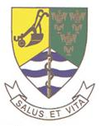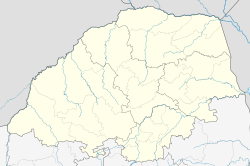Bela Bela
|
Bela-Bela Warmbaths |
||
|---|---|---|
|
||
| Motto: Salus et vita (Latin) | ||
|
|
||
| Coordinates: 24°53′S 28°17′E / 24.883°S 28.283°ECoordinates: 24°53′S 28°17′E / 24.883°S 28.283°E | ||
| Country | South Africa | |
| Province | Limpopo | |
| District | Waterberg | |
| Municipality | Bela-Bela | |
| Established | 1873 | |
| Area | ||
| • Total | 23.29 km2 (8.99 sq mi) | |
| Population (2011) | ||
| • Total | 45,001 | |
| • Density | 1,900/km2 (5,000/sq mi) | |
| Racial makeup (2011) | ||
| • Black African | 89.1% | |
| • Coloured | 1.7% | |
| • Indian/Asian | 0.7% | |
| • White | 8.2% | |
| • Other | 0.3% | |
| First languages (2011) | ||
| • Northern Sotho | 43.0% | |
| • Tswana | 18.1% | |
| • Tsonga | 12.4% | |
| • Afrikaans | 9.4% | |
| • Other | 17.1% | |
| Postal code (street) | 0480 | |
| Area code | 014 | |
Bela-Bela (Tswana: The pot that boils) is a town in the Limpopo Province of South Africa. Deriving its name from the geothermic hot springs around which the town was built, it was formerly called Warmbaths, officially changed to the current name in 2002. Likewise, the Afrikaans name for the town was Warmbad before the name change. It was also previously called Hartingsburg until the early twentieth century.
The town is situated in the Waterberg District of the Limpopo Province. It lies off the N1 road between Pretoria and Polokwane (Pietersburg). Its hot springs produce 22,000 litres per hour at 52 °C (126 °F).
When the Tswana tribes first moved into the region in about the 1800s, they discovered hot springs in the area.
The Voortrekker Carl Van Heerden established the first farm in what is now Bela-Bela and called it Het Bad. In 1873, President Burger's Transvaal government bought the land and established a resort called Hartingsburg after the prominent Dutch biologist Pieter Harting. The British occupied the town during the Anglo Boer War, and renamed the post office Warm Baths in 1903, and proclaimed the boundaries of Warmbaths to be the entire farm of Het Bad.
In 1920 Warmbaths was proclaimed a township (in the legal, not racial sense) and the township was designed by architect John Abraham Moffat in that year. In 1950, it became a magisterial district. In 1932 Warmbaths became a village town and was established as a town council in 1960.
...
Wikipedia




